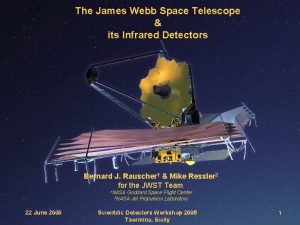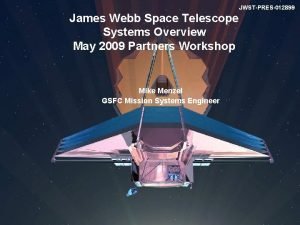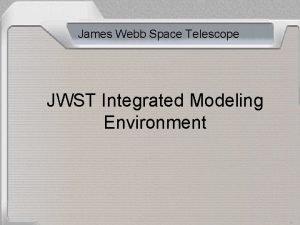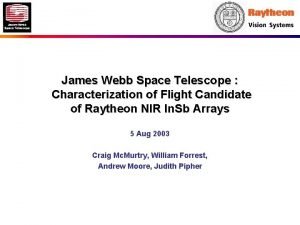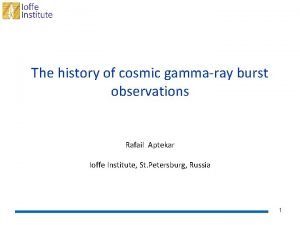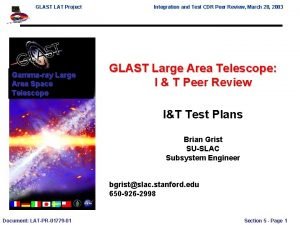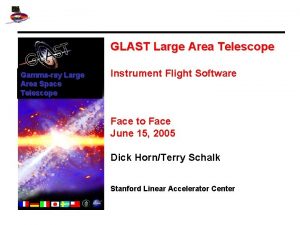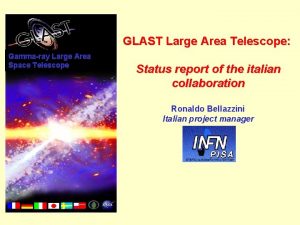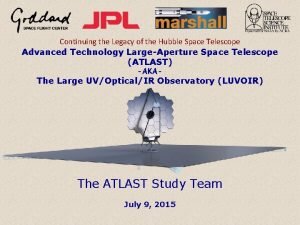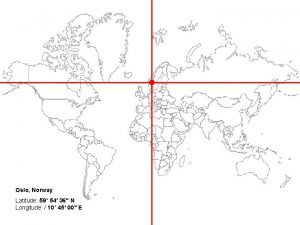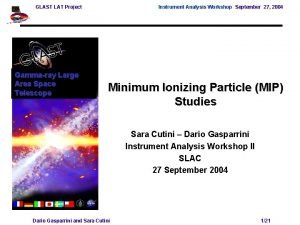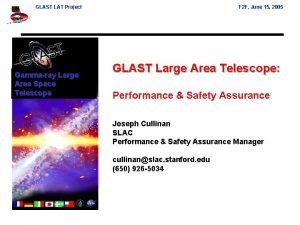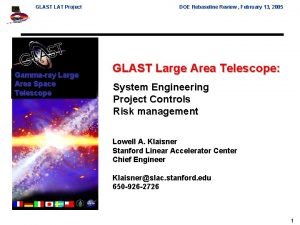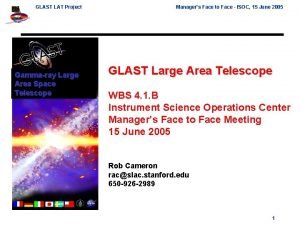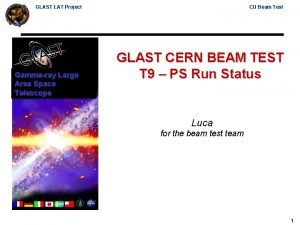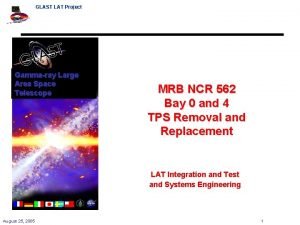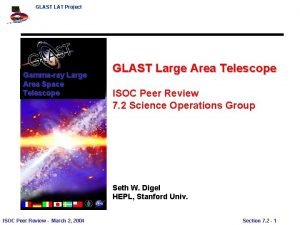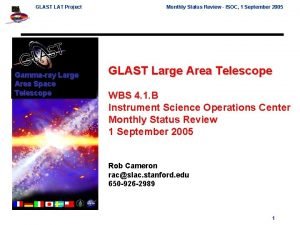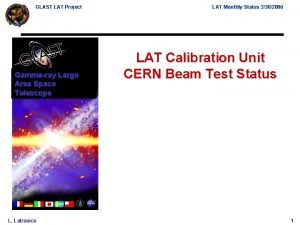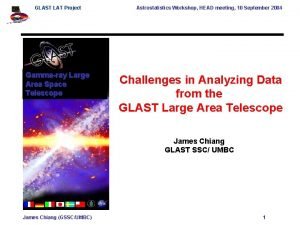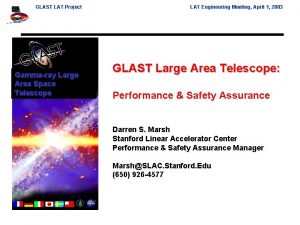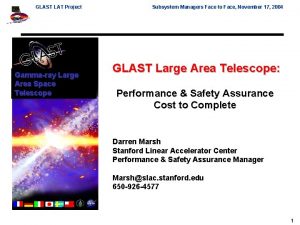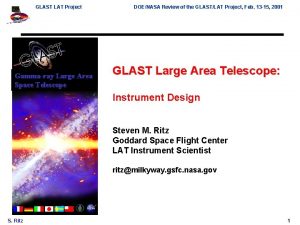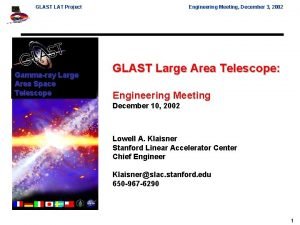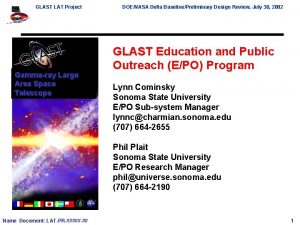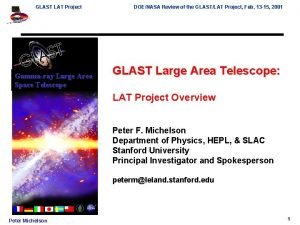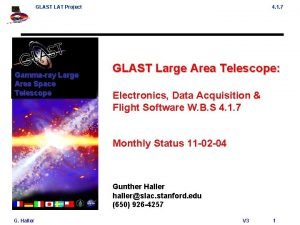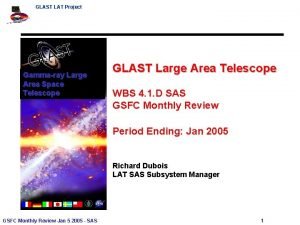GLAST LAT Project Gammaray Large Area Space Telescope




















- Slides: 20

GLAST LAT Project Gamma-ray Large Area Space Telescope DOE Rebaseline Review, February 18, 2005 GLAST Large Area Telescope: Introduction Peter F. Michelson Stanford/SLAC LAT Principal Investigator S. Ritz Goddard Space Flight Center GLAST Project Scientist and LAT Instrument Scientist steven. m. ritz@nasa. gov 301 -286 -0941 1

GLAST LAT Project DOE Rebaseline Review, February 18, 2005 Why study ’s? – rays offer a direct view into Nature’s largest accelerators. – the Universe is mainly transparent to rays: can probe cosmological volumes. Any opacity is energy-dependent. – conversely, rays readily interact in detectors, with a clear signature. Large Area Telescope – rays are neutral: no complications (LAT) due to magnetic fields. Point directly back to sources, etc. Two GLAST instruments: LAT: 20 Me. V – >300 Ge. V GBM: 10 ke. V – 25 Me. V Launch: 2007 5 -year mission (10 -year goal) spacecraft partner: GLAST Burst Monitor (GBM) 2

GLAST LAT Project DOE Rebaseline Review, February 18, 2005 GLAST Science GLAST will have a very broad menu that includes: • Systems with supermassive black holes (Active Galactic Nuclei) • Gamma-ray bursts (GRBs) • Pulsars • Solar physics • Origin of Cosmic Rays • Probing the era of galaxy formation, optical-UV background light • Solving the mystery of the high-energy unidentified sources • Discovery! Particle Dark Matter? Other relics from the Big Bang? Testing Lorentz invariance. New source classes. Huge increment in capabilities. GLAST draws the interest of both the High Energy Particle Physics and High Energy Astrophysics communities. GLAST is the highest-ranked initiative in its category in the National Academy of Sciences 2000 Decadal Survey Report. 3

GLAST LAT Project DOE Rebaseline Review, February 18, 2005 GLAST LAT High Energy Capabilities EGRET on CGRO firmly established the field of high-energy gamma-ray astrophysics and demonstrated the importance and potential of this energy band. GLAST is the next great step beyond EGRET, providing a huge leap in capabilities: • Very large FOV (~20% of sky), factor 4 greater than EGRET • Broadband (4 decades in energy, including unexplored region E > 10 Ge. V) • Unprecedented PSF for gamma rays (factor > 3 better than EGRET for E>1 Ge. V) • Large effective area (factor > 5 better than EGRET) • Results in factor > 30 improvement in sensitivity • Much smaller deadtime per event (25 microsec, factor >4, 000 better than EGRET) • No expendables long mission without degradation 4

GLAST LAT Project DOE Rebaseline Review, February 18, 2005 Sources EGRET 3 rd Catalog: 271 sources 5

GLAST LAT Project DOE Rebaseline Review, February 18, 2005 Sources LAT 1 st Catalog: >9000 sources possible 6

GLAST LAT Project DOE Rebaseline Review, February 18, 2005 Galactic Anticenter Region simulation: S. Digel 7

GLAST LAT Project DOE Rebaseline Review, February 18, 2005 GLAST LAT Collaboration United States • • California State University at Sonoma University of California at Santa Cruz - Santa Cruz Institute of Particle Physics Goddard Space Flight Center – Laboratory for High Energy Astrophysics Naval Research Laboratory Ohio State University Stanford University (SLAC and HEPL/Physics) University of Washington University, St. Louis France PI: Peter Michelson (Stanford & SLAC) • ~120 Members (including ~60 Affiliated Scientists, plus 20 Postdocs, and 25 Graduate Students) IN 2 P 3, CEA/Saclay Italy • INFN, ASI Japanese GLAST Collaboration • • Hiroshima University ISAS, RIKEN Swedish GLAST Collaboration • • Cooperation between NASA and DOE, with key international contributions from France, Italy, Japan and Sweden. Managed at Stanford Linear Accelerator Center (SLAC). Royal Institute of Technology (KTH) Stockholm University 8

GLAST LAT Project DOE Rebaseline Review, February 18, 2005 Overview of LAT • Precision Si-strip Tracker (TKR) 18 XY tracking planes. Single-sided silicon strip detectors (228 mm pitch) Measure the photon direction; gamma ID. • Hodoscopic Cs. I Calorimeter(CAL) Array of 1536 Cs. I(Tl) crystals in 8 layers. Measure the photon energy; image the shower. • Segmented Anticoincidence Detector (ACD) 89 plastic scintillator tiles. Reject background of charged cosmic rays; segmentation removes self-veto effects at high energy. ACD e+ • Electronics System Includes flexible, robust hardware trigger and software [surrounds filters. 4 x 4 array of TKR towers] Tracker e– Calorimeter Systems work together to identify and measure the flux of cosmic gamma rays with energy 20 Me. V - >300 Ge. V. 9

GLAST LAT Project DOE Rebaseline Review, February 18, 2005 Design Performance Validation: LAT Monte-Carlo Model The LAT design is based on detailed Monte Carlo simulations. Integral part of the project from the start. Ø Background rejection Ø Calculate effective area and resolutions. Ø Trigger design. Ø Overall design optimization. Ø Impacts of failures. Ø Science simulations. Simulations and analyses are all C++, based on standard HEP packages. Model validated in a sequence of beam test measurements. Detailed detector model includes gaps, support material, thermal blanket, simple spacecraft, noise, sensor responses… Instrument naturally distinguishes gammas from backgrounds, but details matter. gamma ray proton 10

GLAST LAT Project DOE Rebaseline Review, February 18, 2005 Monte Carlo Modeling Verified in Detailed Beam Tests Experimental setup in ESA for tagged photons: X Projected Angle 3 -cm spacing, 4% foils, 100 -200 Me. V Data Monte Carlo GLAST Data (errors are 2 ) Monte Carlo Published in NIM A 446(2000), 444. 11

GLAST LAT Project DOE Rebaseline Review, February 18, 2005 1999 -2000 Beam Test at SLAC Using beams of positrons, tagged photons and hadrons, with a ~flight-size tower, studies of Published in NIM A 474(2001)19. • data system, trigger • hit multiplicities in front and back tracker sections • calorimeter response with prototype electronics. • time-over-threshold in silicon • upper limit on neutron component of ACD backsplash • hadron tagging and first look at response 12

GLAST LAT Project DOE Rebaseline Review, February 18, 2005 Data Challenges • Early alpha-testing. “End-to-end” testing of analysis software. • Provide feedback on what works and what is missing from the data formats and tools. • Walk before running: design a progression of studies. – DC 1. Modest goals. Contains most essential features of a data challenge. • 1 simulated day all-sky survey simulation • find the sources, including GRBs • a few physics surprises • exercise: – exposure, orbit/attitude handling, data processing pipeline components, analysis tools – DC 2 in 2005. More ambitious goals. ~One simulated month. • toy one-month catalog. • add source variability (AGN flares, pulsars). add GBM. – DC 3 in 2006. Support for flight science production. see http: //www-glast. slac. stanford. edu/software/Workshops/Feb 04 DC 1 Close. Out/coverpage. htm 13

GLAST LAT Project DOE Rebaseline Review, February 18, 2005 The DC 1 Sky One day all-sky survey. Generated E>20 Me. V. E>100 Me. V with some other cuts for illustration Lots to analyze! A few surprises to find… 14

GLAST LAT Project DOE Rebaseline Review, February 18, 2005 Data Challenge 1 Sky 3 C 273 isotropic diffuse 3 C 279 Sources – 3 EG and more, with a twist a number of physics surprises in the DC 1 data, including: • 110 Ge. V gamma-ray line source at the galactic center • new source populations • and… 15

GLAST LAT Project DOE Rebaseline Review, February 18, 2005 Operations Phase LAT Organization Chart § Dr. Rob Cameron appointed LAT Instrument Science Operations Center manager – extensive operations experience at SAO / Chandra X-ray Center § LAT Collaboration Science Groups (LSGs) responsible for collaboration’s analysis and extraction of science results from LAT data – 11 Science Groups plus Multi-l Coordination Working Group – each science group to have 2 coleads; with one resident at Stanford – day-to-day efforts coordinated by Analysis Coordinator, also resident at Stanford-SLAC 16

GLAST LAT Project DOE Rebaseline Review, February 18, 2005 Science Analysis Groups § groups organized around expected collaboration publications, particularly during the 1 st year all-sky survey phase; each group should have responsibility for 2 -3 key (category 1) papers (see Plan posted on meeting Website) Science Analysis Groups 1. 2. 3. 4. 5. 6. 7. 8. 9. 10. 11. Catalogs Galactic Diffuse and Molecular Clouds Extragalactic Diffuse Blazars and Other AGNs Other Galaxies (including clusters) Pulsars, SNRs, and Plerions Unidentified Sources and Population Studies Dark Matter and Exotic Physics Gamma-Ray Bursts Solar System Sources Calibration and Analysis Methods LAT Multiwavelength Observation Coordination Group 17

GLAST LAT Project DOE Rebaseline Review, February 18, 2005 Next LAT Collaboration Meeting SLAC, March 8 -10, 2005 • further develop collaboration plans for LAT I&T data analysis • updates on status of flight hardware development and Instrument integration and test • advance the planning for the science operations and analysis phase – – initial meetings of Collaboration Science Analysis Groups update on Instrument Science Operations Center plans and needs advance the planning for data challenge II update on software development 18

GLAST LAT Project DOE Rebaseline Review, February 18, 2005 Possible Descope • With increasing budget pressures, NASA HQ has asked the LAT team and GLAST Project to assess the science impact of removing the four corner TKR towers. – cost savings generated by schedule reduction of approximately one month – briefing to Anne Kinney on 24 February in preparation – a number of breakthrough science topics significantly affected 19

GLAST LAT Project DOE Rebaseline Review, February 18, 2005 Summary • Flight hardware is being delivered (see Lowell’s talk) – great excitement in the team • Integration and Test activities ramping up • Preparation for science operations and science analysis underway. • Continuing support during this difficult budget time is deeply appreciated by the team. – the science payoff will be great! 20
 Glast tm
Glast tm Poikilodermia civatte
Poikilodermia civatte High definition space telescope
High definition space telescope James webb nasa space telescope launch
James webb nasa space telescope launch James webb space telescope deployment
James webb space telescope deployment James webb space telescope
James webb space telescope Raytheon james webb space telescope
Raytheon james webb space telescope James webb nasa space telescope launch
James webb nasa space telescope launch Fermi space telescope
Fermi space telescope How large is space
How large is space How large is space
How large is space How large is space
How large is space Curreor
Curreor Dwie koparki pracują razem wykonują wykop w ciągu 8 dni
Dwie koparki pracują razem wykonują wykop w ciągu 8 dni Acromioclavicular ligament
Acromioclavicular ligament Suma wieku ani i oli wynosi 22 lata
Suma wieku ani i oli wynosi 22 lata Po'latlar
Po'latlar What is the latitude of oslo norway
What is the latitude of oslo norway Latissimus dorsi innervation
Latissimus dorsi innervation Lat prayers
Lat prayers Runsvenskan
Runsvenskan



